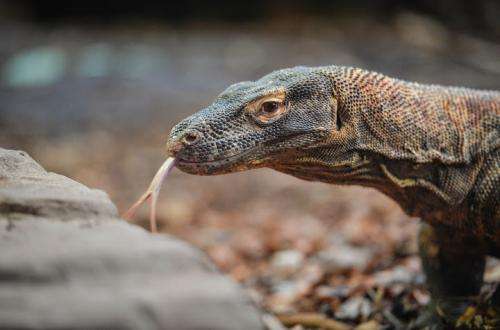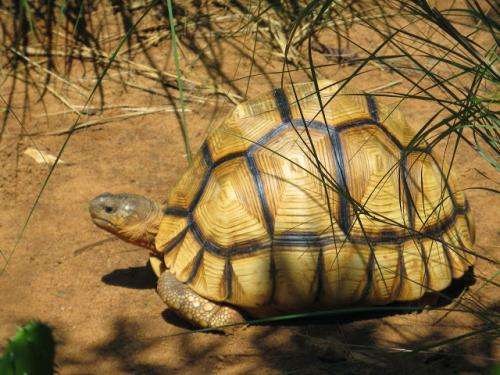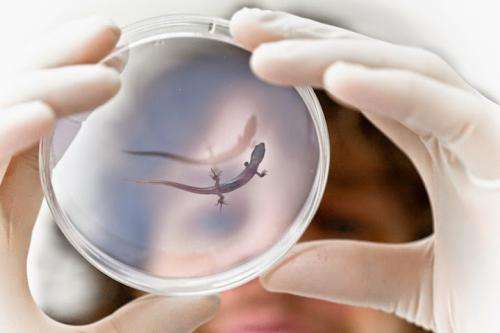Top ten reptiles and amphibians benefitting from zoos

A frog that does not croak, the largest living lizard, and a tortoise that can live up to 100 years are just some of the species staving off extinction thanks to the help of zoos, according to a new report.
The British and Irish Association of Zoos and Aquariums (BIAZA), which promotes the values of good zoos and aquariums, has compiled a list of the top ten reptiles and amphibians benefitting from the aid of zoos in the UK and Ireland.
The golden mantella, the komodo dragon and the Ploughshare tortoise have all made it on to the list, which highlights some of the best examples of how zoos are safeguarding the future of our planet's wildlife and their habitats.
Dr Andrew Marshall, a conservation biologist working in the Environment Department at the University of York and at Flamingo Land near Malton, co-ordinated the list with input from conservation experts based at BIAZA zoos.
Dr Marshall, a member of BIAZA's Field Programmes Committee, said: "Zoos are part of a global conservation community. Last year, BIAZA published a report on the top ten mammals most reliant on zoos, which highlighted the work being done by zoos to help safeguard their future. This year, we have focused on ten prevailing examples of reptiles and amphibians that zoos are working to save from extinction.The list includes some fantastic species, many of which are facing a dramatic decline and are in a desperate situation in the wild."
The nocturnal lemur leaf frog is able to change colour - from a vivid green in daylight, blending in perfectly to the vegetation it rests on, to a murky brown which allows it to hop around safely in the dark. However, the wild population of this species has fallen by half over the last 15 years.
The axolotl is able to regenerate whole limbs or organs if it needs to but it is vulnerable to water-quality changes and is Critically Endangered mainly due to high levels of pollution in its last remaining stronghold in Mexico.

The top ten list demonstrates the importance of zoos not only for conservation breeding of safety-net populations , but also for their contribution to funding and management of conservation projects in the field, including research, education and support for local communities, as well as protection of crucial wildlife habitats.
Strict criteria were used to select the top ten. All the reptiles and amphibians proposed had to be associated with current field initiatives by zoos and/or essential conservation breeding in zoos. Particular importance was given to initiatives which included a management role in the species' conservation, rather than just providing funds. Priority was also given to species listed as threatened on the international IUCN Red List of threatened species.
TV presenter and naturalist, Nick Baker, who is supporting the Top Ten campaign to raise awareness of these species and the work zoos are doing in their aid, said: "Zoos and aquariums have a very important role in this whole thing … at the scariest level they are the ark. They are where the insurance populations of these animals can be looked after and understood and studied."

BIAZA's top ten reptiles and amphibians most reliant on zoos are:
- Axolotl – this Critically Endangered amphibian retains a tadpole-like appearance even as an adult and has the extraordinary ability to regenerate limbs.Golden mantella – These Critically Endangered frogs don't croak! Instead males attract females by a series of clicking noises. This bright yellow frog is known for attempting to eat anything that can fit in their mouth, even if the taste is repulsive.
- Komodo dragon – there are less than 1000 left in the wild.They are the largest living lizard with males growing up to 3m in length and up to 90kg and females can if necessary reproduce on their own.
- Lemur leaf frog – Due to massive habitat loss and the effects of chytrid fungus, this species' range and its population has declined by over 80% over recent years. An adult lemur frog is only 3 to 4 cm long, it could fit on the end of your finger.
- Morelet's leaf frog – these striking lime-green frogs with a pink or orange underbelly are rapidly disappearing as their forest habitat is destroyed. They have incredible jet black eyes with no discernable iris and wide webbing between their toes which allows them to parachute between trees.
- Mountain chicken – One of the largest frogs in the world, this Critically Emdangered species is known as a mountain chicken as it is commonly hunted for food.
- Orange-tailed skink – These beautifully coloured and highly endangered skinks are not easily found and would be extinct if it weren't for the help of zoos.
- Ploughshare tortoise – one of the most sought after reptiles in the illegal pet trade, this Critically Endangered tortoise can live up to 100 years.
- Round Island boa – one of the very few snake species that can change its colour.
- Sand lizard – one of the UK's rarest and most protected lizards.
Provided by University of York

















